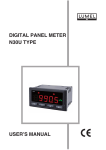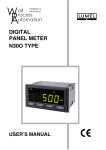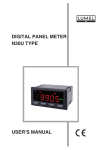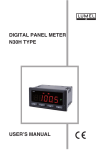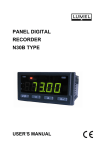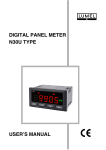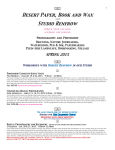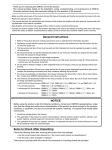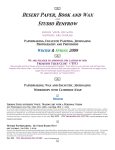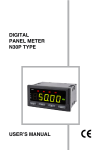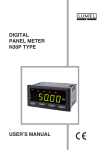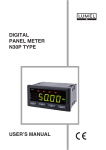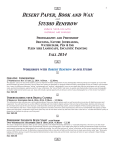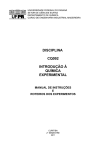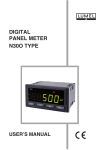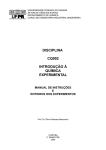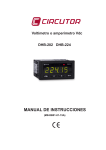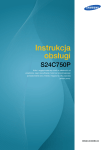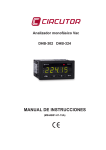Download USER`S MANUAL
Transcript
PANEL DIGITAL RECORDER N30B TYPE USER’S MANUAL 1 CONTENTS 1 APPLICATION AND RECORDER DESIGN...................................... 5 2RECORDER SET............................................................................... 7 3BASIC REQUIREMENTS, OPERATIONAL SAFETY....................... 8 4 INSTALLATION.................................................................................. 9 4.1 Lead-outs of Signals...................................................................11 5SERVICE.......................................................................................... 13 5.1 Display Description..................................................................... 13 5.2 Messages after Switching the Supply on.................................... 14 5.3 Functions of Push-buttons.......................................................... 15 5.4 Programming............................................................................... 19 5.4.1 Way to Change the Selected Parameter Value......................... 22 5.4.2 Changing Floating-Point Values................................................ 22 5.4.3 Setting of Archived Registers.................................................... 22 5.4.4 Characteristic of Programmed Parameters............................... 24 5.4.5 Individual Characteristic............................................................ 37 5.4.6 Alarm Types............................................................................... 39 5.4.7 Display Format.......................................................................... 41 5.5Recorder Configuration to Work in the Master Mode................... 42 5.6Recorder Configuration to Work in the Slave Mode..................... 45 5.7Manufacturer’s Parameters.......................................................... 47 6 INTERNAL ARCHIVE...................................................................... 50 6.1 Memory Structure........................................................................ 50 6.2 Record Construction................................................................... 51 6.3 Archive Data Downloading.......................................................... 52 7MEMORY CARD.............................................................................. 55 7.1 Catalogue Structure................................................................... 56 7.2 Construction of Archive Files....................................................... 57 8 INTERFACE RS-485........................................................................ 59 8.1 Connection Way of the Serial Interface....................................... 59 8.2 Description of the MODBUS Protocol Implementation................ 60 8.3 Description of Applied Functions................................................. 61 8.4 Register Map.............................................................................. 61 8.5 Registers for Write and Readout................................................. 64 8.6 Registers Only for Readout...................................................... 102 8.7 Registers of Values for Readout and Write............................... 106 9E RROR CODES............................................................................. 109 10TECHNICAL DATA.......................................................................110 11ORDER CODES............................................................................113 12 MAINTENANCE AND GUARANTEE...........................................115 1. APPLICATION AND RECORDER DESIGN The N30B recorder is a panel programmable digital instrument, destined to display and archive digital values from connected devices through the RS-485 interface. Additionally, the recorder enables to show the actual time. The readout field is composed of a LED display which allows the exposition of results in colours: red, green and orange. The measured readout values can be freely converted by means of the 21-point individual characteristic. Features of the N30B recorder: Display colour programmed individually in three intervals. • Programmable thresholds of displayed overflows. • • Two relay alarms with NOC contacts operating in 6 modes. • Two relay alarms with switching over contact operating in 6 modes (option). • Signalling of the measuring range overflow. • Automatic setting of the decimal point. • Programming of alarm and analog outputs with reaction on the selected input quantity (any register read out or recorded or real time lock). • Real time lock with the supported supply function of the clock in case of a recorder supply decay. • Automatic change of time from the summer to winter time and inversely (this function can be disabled). • Programmed averaging time – function of walking window with the averaging time up to 1 hour. • Monitoring of set parameters. • Locking of introduced parameters by means of a password. • Recounting of measured value on the base of a 21-point individual characteristic. • • • • • • • • • • • • • • Data archiving in data internal memory with a capacity of 308000 records. Any configuration of the archived data – any values with established time intervals can be archived. Conditional archiving – archiving of alarm states. Service of MMC / SD cards with capacity up to 4GB – - serviced system of FAT and FAT32 files. Automatic copying of the internal archive on the memory card. Signalling of the transmission state and the memory card state on the recorder display. Service of the interface with MODBUS protocol in RTU mode (implemented Master and Slave mode. Data readout of 10 devices with 10 registers in each device. Monitoring of readout/recorded register values directly accessible from the recorder keyboard. Retransmission of read out/recorded quantities into a standard, programmable current or voltage signal (option). Backlight of any measuring unit as per order. Signalling of alarm operation – The alarm supply causes the backlight of the output number. Galvanic separation between terminals: alarming, supplying, analog, RS-485 interfaces ( port 1 and port 2). Protection grade from frontal face: IP65, overall recorder dimensions: 96 x 48 x 93 mm (with terminals). The recorder casing is made of plastics. Fig. 1. View of the N30B recorder 2. RECORDER SET Thesetiscomposedof: N30Brecorder......................... 1pc user’smanual.......................... 1pc Guaranteecard....................... 1pc Clampstofixinthepanel........ 4pcs Seal......................................... 1pc Whenunpackingtherecorder,pleasecheckwhetherthetype andversioncodeonthedataplatecorrespondtotheorder. 7 3. BASIC REQUIREMENTS, OPERATIONAL SAFETY In the safety service scope, the N30B recorder meets the requirements of the EN 61010-1 standard. Symbols located in this manual are: Especially important, one must get acquainted before connecting the recorder. Disregard of notices marked by this symbol can cause the recorder damage. One must take into consideration when the recorder operates inconsistently with expectations. Observations concerning the operational safety: • All operations concerning transport, installation, and commissioning as well as maintenance, must be carried out by qualified, skilled personnel, and national regulations for the prevention of accidents must be observed. • The programming of N30B recorder parameters must be carried out after disconnecting measuring circuits. • Before switching the recorder on, one must check the correctness of connections. • The recorder is destined to be installed and exploited in electromagnetic industrial environment conditions. • • • Non-authorized removal of the housing, inappropriate use, incorrect installation or operation, creates the risk of injury to personnel or recorder damage. For more detailed information, please study the User’s Manual. When connecting the supply, one must remember that a switch or a circuit-breaker should be installed in the building. This switch should be located near the device, easy accessible by the operator, and suitably marked as an element switching the recorder off. 4. INSTALLATION The recorder has separable strips with screw terminals, which enable the connection of external wires of 1.5 mm² cross-sections for the RS-485 object interface and 2.5 mm² for other signals. One must prepare a hole of 92 +0.6 x 45 +0.6 mm in the panel, which the thickness should not exceed 6 mm. The recorder is adapted to be mounted in a panel. The recorder must be introduced from the panel front with disconnected supply voltage. Before the insertion into the panel, one must check the correct placement of the seal. After the insertion into the hole, fix the recorder by means of clamps (fig.2). Fig. 2. Recorder fixing. Fig. 3. Overall dimensions. 10 4.1 Lead-outs of Signals Signals led out on the recorder connectors are presented on the fig. 4. Circuits of successive groups of signals are separated between them. RS-485 interfaces are separated between them and separated from remaining connectors. Galvanic separation Supply Output signals Fig. 4. Description of signals on connection strips. The N30B recorder has one or two led out RS-485 interface operating in MODBUS RTU standard. In case of a recorder version equipped with a plate with additional signals, the interface of the port 1 always operates in master mode, however the interface on the port 2 always operates in slave mode. For versions without additional signals (without the upper plate) the interface of the port 1 11 works depending on the parameter setting in the recorder menu as master or slave (table 1). The OC output is used for signalling the transmission error with devices added on during the master mode operation. Notice !: the memory card must be inserted into the recorder with contacts on the upper side. Before the card insertion, one must acquaint with the memory card description (Chapter 7 of the user’s manual) Notice 12 !: The connection of RS-485 interface signals must be made by means of a wire composed of twisted pairs placed in a braided screen. During the assembly, one must take into consideration that A and B lines constitute one pair of wires twisted together. The screen must be connected to the terminal PE in the nearer proximity of the N30B recorder. 5. SERVICE 5.1 Display Description Alarm indexes Displayed value Transmission signaling on object port The averaging time is not go by Back lighted unit Status indication for card memory Value increasing push-button Value Acceptation change button push-button Resignation push-button Fig. 5. Description of the recorder frontal plate. Special symbols placed on the recorder display mean: • T – transmission symbol on the object port. The symbol is flickering during broadcasting (red colour) or receiving (green colour) data by the recorder. • C – the symbol defines the state of the memory card. In case when the symbol is blank, that means there is no card in the recorder or the card has been disassembled. The symbol in green colour signal the record of data in the memory card. The lighting of the symbol in red colour means an error in the card initiating – the card is damaged, not formatted or the type of card is not serviced. The lighting of symbol in orange colour means that a protection against recording is enabled on the card. 13 • the averaging time is not go by – the index is lighted if the value displayed on the display is not averaged in the full Cnt period. Such an event takes place after connecting the supply or in case of a transmission error with the co-operating device, which the value has to be averaged. After the error decay, the averaging period begins again. 5.2 Messages after Switching the Supply on After switching the supply on, the recorder displays its name and next, the software version in the shape „ x.xx” – where x.xx is the number of the current software version or the number of a custom-made version. Next, the recorder transits to the normal operation and begins to display values according to the set parameter (table 1). When displaying values, the recorder sets automatically the comma position, and at the same time, the format (number of places after the comma) can be limited by the user. 14 5.3 Functions of Push-buttons – Acceptation push-button: entry in programming mode (press and hold down ca 3 seconds), moving through the menu – choice of level, entry in the mode changing the parameter value, acceptation of the changed parameter value, stop the displayed value – when holding down the pushbutton, the result on the display is not updated. – push-button increasing the value: display of the maximal value, The pressure of the pushbutton causes the display of the maximal value during ca 3 seconds. , entry in the level of the parameter group, moving through the selected level, change of the selected parameter value – increasing the value. – push-button changing the digit: display of minimal value, The pressure of the push-button causes the display of the minimal value during ca 3 seconds. entry in the level of parameter group, moving through the selected level, change of the selected parameter value – shift on the next digit. 15 – resignation push-button: entry in the menu monitoring the recorder parameters (by holding down ca 3 seconds), exit from the menu monitoring recorder parameters, resignation of the parameter change, absolute exit from the programming mode. and The pressure of the push-button combination and holding them down ca 3 seconds causes the erasing of alarm signalling. This operation acts exclusively when the support function is switched on. The pressure of the push-button combination causes the erasing of the minimal value. The pressure of the push-button combination causes the erasing of the maximal value. The pressure of the push-button combination causes the entry into the monitoring mode of read out value registers. The register name (orange colour) and the value in the register (green colour) appear alternately on the display. The selection of the currently displayed register is carried out by means of the increasing or decreasing push-button. The name of the displayed register is composed of two values. The first value, preceded by the letter d, means the device number which data have been read out from. The second value preceded by the letter r, means the register number read out from the device. 16 The pressure of the push-button combination causes the data transfer from internal memory onto a card. Till the time to remove, the inscription twinkles interchangeably with the percentage quantity of copied data on the display. After removing the card from the recorder the inscription disappears automatically and the recorder returns to the normal operating mode. The pressure and holding down the pushbutton during ca 3 seconds causes the entry in the programming matrix. The programming matrix can be protected by a safety code. The programming matrix can be protected by a safety code. The pressure and holding down the pushbutton during ca 3 seconds causes the entry to the monitoring menu of recorder parameters. One must move through the monitoring menu by means of and push-buttons. In this menu, all programmable recorder parameters are only available for readout. In this mode, the menu is not available. The exit from the monitoring menu is carried out by means of the push-button. In the monitoring menu, parameter symbols are displayed alternately with their values. The service algorithm of the recorder is presented on the fig. 6. 17 Fig. 6. Service algorithm of the N30B recorder. 18 5.4 Programming The pressure of the push-button and holding it down through ca 3 seconds causes the entry in the programming matrix. If the entry is protected by a password, then the safety code symbol is displayed alternately with the set value 0. The write of the correct code causes the entry in the matrix, the write of an incorrect code causes the display of the symbol. The matrix of transitions into the programming mode is presented on the fig. 6. The selection of the level is made by means of the button, however the entry and moving through the parameters of the chosen level is carried out by means of and push-buttons. Parameter symbols are displayed alternately with their current values. In order to change the value of the selected parameter, one must use the push-button. To resign from the change, one must use the push-button. In order to exit from the selected level, one must choose the ----- symbol and press the push-button. To exit from the programming matrix, one must press the end appears for ca 3 seconds and the recorder transits to the display of the set parameter. In case of leaving the recorder in the parameter programming mode, the automatic abandon of the programming mode (parameter, and next the menu) follows after 30 seconds and the transition to display values of the set parameter. 19 Item 1 2 3 4 ... 7 8 9 Input Parameters of main input rdisp Displayed register Cnt Measurement time Atype Archiving type ----- Ind Parameters of individual characteristic IndCp Number of points of individual characteristic. H1 First point of the indiv. characteristic. Point x. Y1 First point of the indiv. characteristic. Point y. … d1sp Display parameters dp Minimum decimal point coLdo Lower colour coLbe Middle colour coLuP Upper colour ALr1 Alarm 1 P_A1 Type of input quantity of alarm 1 PrL_1 Lower threshold PrH_1 Upper threshold typ_1 Alarm type ... ... ... ... ... ALr4 Alarm 4 P_A4 Type of input quantity of alarm 4 PrL_4 Lower threshold PrH_4 Upper threshold typ_4 Alarm type Out Outputs P_an Type of quantity for analog output An_Lo Lower threshold of analog output an_HI Upper threshold of analog output typ_A Kind of output (volt./current) ser Service set Write standard parameters seCur Introduce the password Hour Set the time Year Set the date -year dev0 addr0 Address of the device No 0 r_ba0 Basic address r_no0 Number of readout registers rtyp0 Type of readout registers 11 ... 20 20 ... ... ... ... ... dev9 addr9 Address of the device No 9 r_ba9 Basic address r_no9 Number of readout registers rtyp9 Type of readout registers X21 Last point of the characteristic Y21 Last point of the characteristic. ----- coLLo Lower threshold of colour change coLHI Upper threshold of colour change ovrLo Lower overflow dLy_1 Alarm delay Led_1 Signalling support ----- ovrHI Upper overflow ----- ... ... ----- dLy_4 Alarm delay Led_4 Signalling support ----- baUd Baud rate Prot Kind of frame addr Device address baud1 Baud rate on the object port prot1 Kind of frame on the object port t_out Waiting time for the response --- date Set the date – month and day Ct Change the time –summer/ winter Unit Backlight the unit test Display test aIU Degree of memory occupancy deL_A Erase the archive --- rfrq0 Scanning frequency Are60 Selection of archived registers Afrq0 Archiving frequency atyp0 Kind of archiving dprL0 Lower threshold of conditional archiving dprH0 Upper threshold of conditional archiving --- ... ... ... ... ... ... --- rfrq9 Scanning frequency Are69 Selection of archived registers Afrq9 Archiving frequency atyp9 Kind of archiving dprL9 Lower threshold of conditional archiving dprH9 Upper threshold of conditional archiving --- Fig. 7. Programming matrix. 21 5.4.1 Way to Change the Selected Parameter Value In order to increase the value of the selected parameter, one must press the push-button. A single pressure of the push-button, causes the increase of the value of 1. The increase of value when displaying the digit 9 causes the setting of 0 on this digit. The change of the digit follows after pressing the push-button. In order to accept the set up parameter, one must hold button. Then, the write of the parameter down the and the display of its symbol follows alternately with the new value. The pressure of the push-button during the change of the parameter value will cause the resignation of the write. 5.4.2 Changing Floating-Point Values The change is carried out in two stages (the transition push-button): to the next stage follows after pressing the 1) setting the value from the range -19999…99999, similarly as for integral values; 2) setting of the decimal point position (00000., 0000.0, 000.00, 00.000, 0.0000); the push-button shifts the decimal point to the left, however the pushbutton shifts the decimal point to the right; push-button during the change The pressure of the of the parameter value will cause the resignation of the write. 5.4.3 Setting of Archived Registers The setting of archived registers are carried out in the configuration menu of devices (group n, where n defines the device number) after choosing the parameter n , where n defines the device number. After choosing the parameter, 10 vertical lines will be displayed on the dis22 play. Lines symbolize registers ( from the left side, first read out register). The lighting of lines in green colour means, that the register archiving is enabled. The lighting of lines in red colour means, that the register archiving is disabled. The first register read out from the device No 0 is placed in the register 8000, however the second read out register in the register 8001 etc. For the second device, the first read out register will be placed in the recorder register 8010. The second register is read out in the register 8011, etc. Remaining read out registers will be placed in a similar way. During the programming of registers, which have to be archived, the push-button serves to choose the register number, however the push-button serves to change the state – to enable or disable the archiving of the given register. The exemplary view during programming is presented on the fig. 8. Register archiving enabled First read out register Register archiving disabled Fig. 8 Way of register archiving presentation The presented drawing means that for the selected device, read out registers 1, 2, 4 and 10, will be archived. E.g., for the device No 0, that will be registers 8000, 8001, 8003 and 8009. 23 5.4.4 Characteristic of Programmed Parameters Programming parameters and the change range of their quantities are presented in the table below. Table 1 Parameter symbol Input Rd1sp Cnt atype 24 Description Range of changes Selection of displayed register. The selected register can be averaged with the set averaging time and can be submitted to conversion on the base of the individual characteristic. D0r0 .. d9r9 – number of the displayed register in the form dnrm, where: n – device number, m – number of read out register from the device. HoUr – current time. Measurement time 1…600 s expressed in seconds. The result on the display represents the mean value calculated in the Cnt. period. This parameter is not taken into consideration during the time display. Recorder operating type. Defines the way of recorder interface operating and enables the archiving switching on or off. stop – Stopping of archiving and device polling. sLv – operating in slave mode without archiving. In the case of a version with an additional output plate, the upper interface operates in the slave mode, however the object interface is not used. For a version without additional outputs, the object interface operates in the slave mode. Slv A – similar operation as for sLv, but the archiving is enabled. nas – Operation in master mode. The interface of the port 1 operates in the master mode, however the interface of the port 2 (on the additional output plate) operates in the slave mode. Nas A – Operation as in the nas, mode, but the archiving is enabled. Table 2 Parameter symbol Ind IndCp Description Number of points of the individual characteristic. For values lower than two the individual characteristic is disabled. The number of segments is the number of points decreased by one. In the HoUr mode , the individual characteristic is not taken into consideration. Range of changes 1..21 Hn Value of the point for which we will expect -19999..99999 yn (n - point number). yn Expected value for Xn. -19999..99999 25 Table 3 Parameter symbol dIsp Description Range of changes 0.0000 – 0 00.000 – 1 000.00 – 2 0000.0 – 3 00000 – 4 dp Minimal position of the decimal point when displaying the value – display format. This parameter is not taken into consideration during the Hour mode. CoLdo Display colour, when the displayed value is lower than CoLLo. CoLbe Display colour, when the displayed Red – red value is higher than CoLLo and lower 6reen – green oran6 – yellow than COLHI. CoLup Display colour, when the displayed value is higher than COLHI. CoLLo Lower threshold of colour change -19999..99999 COLHI Upper threshold of colour change -19999..99999 ovrLO Lower threshold of display narrowing. Values lower than the declared threshold are signalled on the display by the symbol - - - - - . -19999..99999 ovrHI Upper threshold of display narrowing. Values higher than the declared threshold are signalled on the display by the symbol - - - - - . -19999..99999 26 Table 4 Parameter symbol ALr1, aLr2, aLr3, aLr4-19999..99999 p_A1, p_A2, p_A3, p_A4, Description Range of changes Input quantity, con- D0r0 .. d9r9 – Number of the read trolling the alarm. out register in the form dXrY, where: X – device number, Y – number of the read out register from the device. Hour – current time Inp – value on the display PrL_1, Lower alarm thresprL_2, hold. prL_3, prL_4, -19999..99999 PrH_1, Upper alarm thresprH_2, hold. prH_3, prH_4, -19999..99999 typ_1, Alarm type. Fig. 11 n-on – normal (transition from 0 to 1) typ_2, shows the graphi- n-off – normal (transition from 1 to 0). typ_3, cal presentation on - enabled typ_4, of alarm types. off – disabled H-on – Manually enabled. Till the time to change the alarm type, the alarm output remains enabled for good. H-off – Manually disabled. Till the time to change the alarm type, the alarm output remains disabled for good. 27 dLy_1, Delay of dLy_2, switching. dLy_3, dLy_4, Led_1, Led_2, Led_3, Led_4, alarm 0…32400 s Support of alarm signalling. In situation when the support function is enabled after stopping the alarm state, the signalling diode is not blank. It signals the alarm state till the moment of its blank by means of the push-button combination. The function concerns only and exclusively the alarm signalling, thus the relay contacts will operate without supporting in accordance with the selected alarm type. 28 off – function disabled on – function enabled Table 5 Parameter symbol out Description Range of changes P_An Input quantity, to which D0r0 .. d9r9 – register the analog output has number readout in the form to react. dXrY, where: X – device number, Y – register number read out from the device. Hour – current time Inp – value on the display An_Lo Lower threshold of the analog -19999..99999 output. One must give the value, on which we want to obtain a minimal signal value on the analog output. An_HI Upper threshold of the ana- -19999..99999 log output. One must give the value, on which we want to obtain a maximal signal value on the analog output (10 V or 20 mA). typ_a Type of analog output 0.10U – voltage 0..10 V 0_20A – current 0..20 mA 4_20A – current 4..20 mA 29 baud Baud rate of the external interface RS-485 of port 2 4.8 – 4800 bit/s 9.6 – 9600 bit/s 19.2 – 19200 bit/s 38.4 – 38400 bit/s 57.6 – 57600 bit/s 115.2 – 115200 bit/s prot Type of the transmission r8n2 frame of the external interface r8e1 RS-485 of port 2. r8o1 r8n1 addr Recorder address. The write of zero value cause the disable of the port 1interface. baud1 Baud rate of the object 4.8 – 4800 bit/s interface RS-485 of port 1. 9.6 – 9600 bit/s 19.2 – 19200 bit/s 38.4 – 38400 bit/s 57.6 – 57600 bit/s 115.2 – 115200 bit/s prot1 Type of the transmission r8n2 frame of the interface RS-485 r8e1 of port 1. r8o1 r8n1 t_out Waiting time to begin 100…5000 ms the response from the co-operating device of slave type. This time is expressed in milliseconds. 0..247 Notice! In the version without additional outputs, one can switch the port 1 interface to operate in the interface mode for programming – Operation in the slave mode. Then, the recorder accepts settings in accordance with baud1, tryb1, addr. 30 Table 6 Parameter symbol ser Description Range of changes set Write of manufacturer’s set- No – do nothing tings. The setting of yes value yes – causes the write causes the write of standard of manufacturer’s settings. parameters in the recorder. Values of manufacturer’s parameters are presented in the table X. seCur Introduction of a new 0..60000 password. The introduction of the value 0 disables the alarm. Hour Setting of the current time. Introduction of an erroneous time cancels the introduction of time.The introduced value will not be collected. Year Setting of the current year. 2001…2099 The introduction of an erroneous year cancels the data introduction The introduced value will not be collected. Ct Automatic change of time from off – automatic change summer to winter and inver- of time disabled sely. on – automatic change of time enabled. 0.00..23.59 31 UnIt Backlight of the unit. off – backlight of units disabled on – backlight of units enabled test Display test. The test consist on a successive lighting of digits. Alarm diodes and diodes of unit backlight should be lighted. no – do nothing yes – causes the test start. The pressure of the push-button ends the test. AIU Fulfilling of the archive internal memory . This value is not only for readout and is expressed in percentage. 0…100 % deL_A Command to erase the archi- no – do nothing ve internal memory. After cho- yes – erase the archive osing yes, archive data will be memory removed and the value no will be admitted. stat Displays the state of devi- No concerned ces added to the recorder. In case, when one of the bar is in red colour, that means there is a transmission error with the given device. The first bar from the left side symbolizes the device No 0. 32 Table 7 Parameter symbol D0r0 .. d9r9 Description Range of changes Addr0 …... addr9 Address of the cooperating device. The write of the 0 value disables the data readout from the device. 0..247 r_ba0 …... r_ba9 Basic address from which follows the data readout from the device. 0…65535 r_no0 …... r_no9 Number of regi- 1…10 sters read out from the device. rtyp0 … ... rtyp9 Type of registers Read-out registers with function 3 read out from 3 CH – 8 bits with a sign. the device. 3 UCH – 8 bits without a sign. 3 sh – 16 bits with a sign. 3 ush – 16 bits without a sign. 3 L6 – 32 bits with a sign. 3 UL6 – 16 bits without a sign. 3 FLt – 32-bit register– floating point variable. 3 F21 – value of float type located in two 16-bit registers with bytes sequence 3210. 3 F12 – value of float type located in two 16-bit registers with bytes sequence 1032. 33 3 L21 – value of long type with a sign located in two 16-bit registers with bytes sequence 3210. 3 L12 – value of long type located in two 16-bit registers with bytes sequence 1032. 3uL21 – value of long type with a sign located in two 16-bit registers with bytes sequence 3210. 3uL12 – value of long type without a sign located in two 16-bit registers with bytes sequence 1032. Read-out registers with function 4 4 CH – 8 bits with a sign. 4 UCH – 8 bits without a sign. 4 sh – 16 bits with a sign. 4 ush – 16 bits without a sign. 4 L6 – 32 bits with a sign. 4 UL6 – 32 bits without a sign. 4 FLt – 32-bit register– floating point variable 4 F21 – value of float type located in two 16-bit registers with bytes sequence 3210. 4 F12 – value of float type located in two 16-bit registers with bytes sequence 1032. 4 L21 – value of long type with a sign located in two 16-bit registers with bytes sequence 3210. 4 L12 – value of long type with a sign located in two 16-bit registers with bytes sequence 1032. 4uL21 – value of long type without a sign located in two 16-bit registers with bytes sequence 3210. 4uL12 – value of long type without a sign located in two 16-bit registers with bytes seque- nce 1032. 34 freq0 …... freq9 Sampling period (data read-out from the device Expressed in seconds. 1…60 s Are60 …... are69 Archived registers. The menu serves for the register configuration, which will be archived, and which will be only read-out (see section 5.4.3.). No concerned Afrq0 …... afrq9 Archiving period 1…360 expressed in tens of second. The value 1 corresponds to the 10 sec time. It defines the length of periods in which data read out from the device have to be placed in the archive. Atyp0 …... atyp9 Kind of archi- Cont – continuous archiving ving. The user can re60 … re69 – register number read out, choose the conti- which the value decides nuous archiving or about the beginning indicate the register of the conditional archiving. which value will decide about the conditional archiving beginning. The archiving begins if the value in the indicated register does not be situated in the range defined by dnPrL and dnPrh, where n – device number. 35 d0prL … ... d9PrL Lower threshold -19999…99999 of the conditional archiving. Below this value, the conditional archiving begins – if this type of archiving has been chosen. d0prH … ... d9PrH Upper threshold -19999…99999 of the conditional archiving. Above this value, the conditional archiving begins – if his type of archiving has been chosen. 36 5.4.5 Individual Characteristic N30B recorders can recount the value to display into any value thanks to the implemented individual characteristic function. The individual characteristic rescales the input signal stored/read out through the RS-485 interface. The way of the individual characteristic interaction on the recorder operation has been presented on the fig. 9. Displayed value Stored/read out value Individual characteristic Steering of analog outputs Steering of alarms RS-485 interface Fig. 9. Action of the individual characteristic. 37 The user can introduce maximally twenty functions through given points defining intervals and expected values for successive points. The programming of the individual characteristic consists in the definition of the number of points which the input function will be linearized by. One must remember, that the number of linearizing functions is of one less than the number of points. Next, one must program successive points by giving the measured value (Hn) and the expected value corresponding to it, – value which has to be displayed (Yn). The graphic interpretation of the individual characteristic is presented on the fig. 10. Fig. 10. Individual characteristic. 38 During the function approximation, one must remember that for the approximation of curves strongly differing from the linear characteristic, higher the number of linearizing segments smaller the error related to the linearization. If measured values are smallest from H1 then, recalculations will be made on the base of the first straight line calculated on the base of points (H1,Y1) and (H2,Y2). However, for values higher than Hn (where n – the last declared measured value), the value to display will be calculated on the base of the last assigned linear function. Notice! All introduced points of the measured value (Hn) must be arranged in the increasing sequence, such to preserve the following dependence: H1<H2<H3…<Hn If the above is not fulfilled, the individual characteristic function will be automatically switched off (will not be realized) and a diagnostic flag will be set up in the status register. 5.4.6 Alarm Types The N30B recorder is equipped with 2 alarm outputs with NOC contact (make contact) and two alarm outputs with NOC/NCC contact (make and break contact) (option). Each of alarms can work in one of the six modes. The work of alarms in modes n-on, n-off, on, off. is presented in the fig. 11. Two remaining modes: H-on and H_off mean suitably, always switched on and always switched off. These modes are destined for the manually simulation of alarm states. 39 Alarm output output switched on output switched off Steering quantity a) n-on Alarm output output switched off output switched on Steering quantity Alarm output b) n-off output switched on output switched off output switched off Steering quantity Alarm output c) on output switched on output switched on output switched off Steering quantity d) off Fig. 11. Alarm types: a) ; b) ; c) ; d) 40 Caution! In case of alarms of n-on, n-off, on, off types, the write • of PrL > PrH will cause the alarm switching off. In case of a measuring range overflow, the reaction • of relays is compatible with written PrL, PrH, tyP. The recorder controls currently the value of the introdu• ced parameter at the moment. In case when the introduced value overflows the upper change range given in the table 1, the recorder will make automatically the change into the maximal value. Similarly, in case when the introduced value overflows the lower change range given in the table 1, the recorder will make automatically the change into the minimal value. 5.4.7 Display Format The N30B recorder adapts automatically the display format (precision) to the value of measured quantity destined to be displayed. So that the function could be fully used, one must choose the format 0.0000, then the recorder will display the measured value with the possible highest accuracy. This function does not operate for the time display, where the format is set up automatically. The current time (mode o) is displayed in the 24 hours’ format, in the hh.mm shape, where hh – current hour, and mm – current minute. 41 5.5 Recorder Configuration to Work in the Master Mode The N30B recorder using the port 1 interface can fulfil the role of master of the MODBUS RTU network, reading out data from added devices. Maximally, the recorder can pool 10 devices, and can maximally read out 10 registers from each device. For data readout from devices the function MODBUS readout of n-registers (No 3) is used. If there is the need to readout a higher number of registers from the given device, one must configure the readout from the device as two devices (e.g. menu dev0 and dev1) with different basic addresses. The recorder configuration to work in the master mode consists in: setting the option on the value in the menu • (data readout without archiving or (readout and data archiving). configuration of transmission parameters in the t menu. • One must configure parameters: (baud rate), (type of data frame) and (waiting time to begin the response from co-operating devices). configuration of readout parameters from devices. • In the menu, where n – device number, one must configure readout parameters for the given device by giving: the device address n, the basic register from which will follow the readout of n , the number of registers that will be read out, the type of registers including data in the device from which the readout n will be carried out, the device sampling period expressed in seconds and defining sequences of time in which the device - parameter n. 42 • configuration of archiving parameters, data read out from devices. For his aim, one must configure following parameters: n – one must define, which among read out registers have to be archived. n – one must define the period between successive data records in the archive for the given device. n – defines the type of archiving. One must choose if the archiving have to be carried out in a continuous way or in dependence of the value in the register controlling the conditional archiving. In case of conditional archiving the parameter n indicates the read out register number controlling the conditional archiving. n – lower threshold of the conditional archiving. This parameter has a significance only for a conditional archiving. If the value in the controlling register is lower than the value definite byn, then the archiving of indicated registers takes place with the archiving period determined by the parameter Apn. n – upper threshold of the conditional archiving. This parameter has a significance only for a conditional archiving. If the value in the controlling register is higher than the value definite byn, then the archiving of indicated registers takes place with the archiving period determined by the parameter n. the operation in the master mode the recorder sounds out devices in the network and read out data from them are available in data registers (registers 8000…8099). Devices are pooled in a sequence acc. to the configuration (dev0, dev1, dev2 etc.) although the pooling frequency of devices, for a large degree, depends on the rate of devices 43 operating on the bus. For devices with a long response time it can be happened, that the time between successive data readouts from devices is longer than the time set in the recorder configuration. The difference of times results from the waiting time for the device response and the duration of data transmission. In case of a long waiting time setting for the response and lack of device from which have to follow readouts, the recorder after each query transmission is waiting for the defined time (by the t_out), parameter) , and for this reason, in case if the co-operating device is switched off from the network, one must switch off its service in the N30B recorder through the setting of the variable n on the value 0 (device switching off). The recorder operating in the master mode with data archiving (nas a value of the Atype parameter in the Input menu) causes, that the recorder archives data in the internal data memory, and in case the memory is full, the data will be automatically copied on the memory card. When the card is missing, the oldest data will be overwritten. The readout of internal data memory, in case of a recorder without additional outputs (port 2) is possible in two ways: Location of a memory card in the recorder. After pressing • of the push-button data from the internal archive memory will be automatically copied in the memory card, and after finishing the copying process, data from the internal memory will be erased, so as after the next archive readout only new records will be added in the card. After finishing the copying process (the SynCh) inscription disappears) the card can be disassembled and removed (see recorder service, chapter 5). Data readout through the interface of the port 1. • For this aim, one must set the parameter at the value in the menu. The object interface will be switched in the slave working mode 44 with parameters determined by addr, baud1, prot1. After finishing the data readout, in order to return to the normal operation, one must change the ATYPE parameter into the previous value (e.g NAS A). During the operation in master mode, the user has the possibility to check the co-operation correctness of the recorder with added devices. For this aim, one must choose the option from the menu level. Vertical bars will be displayed on the recorder display where the first bar from the left corresponds to the device No 1 (), the second, to the device No 2 () etc. Bars in green colour mean a correct communication with the given device. In case of a data transmission error, the bar symbolizing the device lights in red colour. 5.6 Recorder Configuration to Work in the Slave Mode N30B recorders can operate in the slave mode. For a recorder without additional outputs (port 2) the operation in slave mode is carried out using the port 1interface. However, for a recorder with assembled upper plate of additional outputs, the operation in slave mode is always carried out using the port 2 located on the plate with additional outputs. This interface always fulfils the slave role, and the choice of the slave mode switches on the possibility to write data in data registers 8000…8099 on, which can be additionally archived. The recorder switching in the slave mode requires the setting of the parameter on the value in the menu (operation without archiving) or (operation with archiving of recorded values). During the operation in slave mode, connector parameters depend on the used interface. For the port 2 interface, transmission parameters are determined by: 45 • addr – defines the device address. baud – baud rate. • prot – type of the information frame. • For a recorder with the additional plate of outputs, transmission parameters on the port 1 are defined by parameters: addr – defines the device address. • baud1 – baud rate. • prot1 – type of the information frame. • After performing the configuration of transmission parameters ( menu) and choosing the working mode ( menu), the recorder is ready to work in slave mode. Data can be recorded and read out from the recorder. For recording data which have to be archived, displayed, have to control alarms or analog outputs, 32-bit registers of float type 8000…8099 (or registers 8200..8399/8400...8599 – float value located in two 16-bit registers) are destined. The value located in data register can be reviewed from the recorder level through the entry in the value monitoring mode (see section 5.3). Values stored in register 8000..8099 can be archived. The archiving is carried out in a similar way as archiving in the master working mode (see section 5.5.), where read out values from devices are located in registers 8000…8099. In order to switch the archiving of the given register on, one must set the n variable (n – device number) in the n menu. Although, the first ten registers (8000..8009) are available in the 0 menu etc. The second group of ten registers are available in the menu, etc.The kind of archiving depends on the n parameter. However the archiving period is defined by the n parameter. The archive readout in slave mode can be carried out directly by the mediation of the interface operating in the slave mode or through copying the archive on the memory card 46 (see section 5.5.). The degree of archive occupation can be checked in the menu of the recorder ( parameter). From the menu level, one can erase the archive contents ( parameter). During the data archiving configuration in slave mode, one must remember that the configuration of archived registers is carried out in 10 groups, where for each group, one can configure parameters related to: archived register, frequency and archiving type. The detailed recorder register map and serviced functions are presented in the chapter 8. 5.7 Manufacturer’s Parameters Standard settings of the N30B recorder are presented in the table 5. These settings can be restored by means of the recorder menu through the choice of the option from the menu . Table 8 Parameter symbol Matrix level Default value rdisp 1 HoUr Cnt 1 1 Atype 1 Stop IndCP 2 no H0 2 0 Y0 2 0 H1 2 100 2 100 … … Y1 47 48 Hn 2 (n-1)*100 Yn 2 (n-1)*100 dp 3 0 CoLdo 3 6reen CoLbe 3 oran6e CoLUp 3 red CoLHI 3 5000 CoLLo 3 8000 ovrLo 3 -19999 99999 ovrHI 3 P_A 1, P_A 2, P_A 3, P_A 4 4, 5, 6, 7 d0r0 typ 1, typ 2, typ 3, typ 4 4, 5, 6, 7 H-off prL 1, prL 2, prL 3, prL 4 4, 5, 6, 7 1000 prH 1, prH 2, prH 3, prH 4 4, 5, 6, 7 2000 dLy 1, dLy 2, dLy 3, dLy 4 4, 5, 6, 7 0 Led 1, Led 2, Led 3, Led 4 4, 5, 6, 7 off Pan 8 d0r0 An_Lo 8 0 An_HI 8 99999 typ_A 8 0_10U baud 8 9.6 prot 8 r8n2 addr 8 1 baud1 8 9.6 prot1 8 r8n2 t_out 8 500 set 9 seCur 9 0 Hour 9 No concerned Year 9 No concerned CT 9 off Unit 9 off TEST 9 no AIU 9 0 deL_a 9 no No concerned no stat 9 Addr0 … Addr9 10…19 off r_ba0 … r_ba9 10…19 7505 r_no0 … r_no9 10…19 1 rtyp0 … rtyp9 10…19 3 flt rfrq0 … rfrq9 10…19 1 Are60 … Are69 10…19 0 Afrq0 … Afrq9 10…19 1 Atyp0 … Atyp9 10…19 Cont d0prL … d0prL 10…19 100 d0prH … d0prH 10…19 200 49 6. INTERNAL ARCHIVE N30B recorders are equipped in standard with an internal memory destined to store registered data by the recorder. The recorder memory allows to store 308000 records. The memory have the character of a circular buffer. After fulfilling the memory, the oldest data are overwritten. The internal archive can be read out, copied and erased. After the insertion of the memory card, follows it’s checking, archiving of the date and time of its insertion. After fulfilling the internal archive, the data will be automatically transferred onto the card. The further archiving is carried out in the internal memory. In every moment one can copy the data from internal memory onto the memory card through pressing the push-button. 6.1 Memory Structure The internal recorder memory is divided in 7000 pages. 44 records of archived data can be located in each memory page. On the page, records begin always from the beginning of the page and occupy the whole page space. Each memory page includes 528 bytes (one can store together 308000 records). The beginning of archive data is determined by the page number on which there is the first archive record and by the initial byte determining from which byte begins the first record. The archive end is determined in the similar way through the page number on which there is the last page record and the byte where begins the record of the next archive record. Data of internal archive memory are stored in the shape of records including 12 bytes. 50 6.2 Record Construction All data in the internal data memory are stored in the shape of records composed of 12 bytes. The record structure is presented in the table 9. Table 9 Field name Value range Description Field type ID 0..9 Knot identifier – Device number byte from which the data origins RegID 0..9 read out register number, which byte the value is stored Year 1..255 Year. Value 9 means 2009. byte Month 1..12 Month. byte Day 1..31 Day. byte Hour 0..23 byte Minute 0..59 byte Second 0..59 byte Data --- Data archived in the float format 4 bytes 51 6.3 Archive Data Downloading Downloading of archive data from the internal memory is carried out through the mediation of the memory card or through the interface operating in the slave mode (see sections 5.5 and 5.6). The algorithm of archive data downloading through the mediation of the RS-485 interface is presented below. The presented description includes only the way to download data without the description of further data processing and data conversion. The archive data downloading consists to download successive memory pages including records with data. The archive downloading algorithm is presented on the fig. 12. 52 START Readout of the archive beginning and end Data were collected in the archive NO YES Calculation of the number of pages to download Downloading of pages Downloaded memory pages NO YES Rejection of needless records (data ordering) END Fig. 12. Algorithm of archive readout from the internal memory. 53 Acc. to the presented figure above, in order to download data from the internal archive memory, one must download in the first sequence the beginning and the end of the archive (values in registers 4046..4049). On the base of registers 4046 and 4047, determine the number of pages to download from equations: ls = R4047 - R4046 +1; or from the equation: ls = 7000 + R4046 - R4047, if the value of the initial page is higher than the value of the last page (the memory has the structure of a circular buffer). If the initial page and the last page are equal each other and registers 4048 and 4049 are equal each other, that means that the archive is empty. In the contrary, download the number Is of pages, beginning from the indicated page by the register 4046. After writing the number of the read out page in the register 4500, one can read out from registers 4501…4764 the page contents from the internal memory. Begin the page downloading by the write of the page number, which we want to download in the register 4500, and next the readout of registers 4501…4764 ( (memory page with number placed in the register 4500). We download all pages in the similar way, till the moment of downloading of all required pages (Is). After downloading the memory contents, we divide the downloaded contents into records (1 record equals 12 bytes). After performing the division into records, filter data by the rejection of records in front, then the number of records to be rejected in front is calculated as the contents of the register 4048/12. after the rejection of records in front, reject records from the end. The number of records to reject from the end is calculated as: 528 – value of register 4049)/12. After the rejection of records we obtain ready data in the memory (e.g. in the table). 54 7. MEMORY CARD N30B recorders are serviced by memory cards of MMC and SD types and capacity up to 4 GB. The FAT and FAT32 system of files is serviced. In case, when the possessed memory card is not formatted, one must carry out its formatting in the card reader from the computer level. During the work, the N30B recorder creates catalogues and files including archived data. Before the card insertion into the recorder, one must check whether the card does not have a switched protection against recording. Notice! One must never pull out the memory card from the recorder before its disassembling when the data are transferred from the internal memory onto the card (see section 5.3). The memory card state is displayed by the marker placed on the recorder display (see section 5.1.) and is contained in the recorder’s registers (see section 8.4.). Below an exemplary number of records on the card for 10 archived devices (with 10 registers in each) with the quickest updating time (every 10 seconds): 64 MB: ca 4 320 000 records ( ca 120 hours – 5 days) 512 MB: ca 34 560 000 records ( ca 960 hours – 40 days) 2 GB: ca 136 512 000 records ( ca 3792 hours – 158 days) Notice! The time needed to transfer the data from internal memory depends on the card and can take even about an hour. 55 7.1 Catalogue Structure The N30B recorder installs catalogues and files in the memory card during archiving. The exemplary catalogue structure is presented on the fig. 13. \ LUMEL N30B System Recorder series number Archives 10050001 2010 06 07 Fig. 13 Catalogue structure in the memory card. 56 Beyond the Archives catalogue, the System catalogue is also created on the card, in which the start.txt file is placed. The date and time of the memory card initialization is stored in this file ( also during the start after a supply decay). Data on the card are stored in files located in catalogues corresponding to the date – see fig 13. However, file names correspond to numbers of the archiving day: Day_01.dat, Day_02.dat, etc. 7.2 Construction of Archive Files Files including archive data, have a bar (column) construction, where successive data bars are separated between them by the tabulator mark. In the first file row, the bar heading is placed. Data records are arranged successively in rows, and fields of the given record are separated between them by the tabulation mark. The view of an exemplary file is presented on the fig. 14. Fig. 14 Exemplary file with data. 57 Successive fields included in the row and describing the record have the following meaning: date – date of data registration. The date separator • is the mark: ‘-‘. time – time of data registration. The time separator • is the mark: ‘:’. DEV – device number – value 0 for dev0, 1 for dev1, etc. • R0..R9 – value of successive registers. The decimal point • is the dot: ‘.’ . Values are stored in the engineer’s format allowing to preserve the precision. Notice: The number of rows in the file depends on the number of stored data. For 10 devices archived 10 seconds, the number of lines in the dayly file is 86402 (8640 for each device). For this reason, before beginning the data analysis, one must be sure that the used program (e.g.: Excell) services such a number of rows. 58 8. interfACE rs-485 Programmable digital N30B recorders have one or two serial links in RS-485 standards for the communication in computer systems and with other devices fulfilling Master or slave functions. An asynchronous communication character protocol MODBUS has been implemented on the serial link (links). 8.1 Connection Way of the Serial Interface The RS-485 standard allows to a direct communication of 32 devices on a single serial link of 1200m long (at baud rate 9600 b/s). For the connection of a higher quantity of devices, it is necessary to apply additional intermediate-separating systems, e.g. PD51 converter, of LUMEL S.A.’s production. The outlet of the interface line is presented on the fig. 4. To obtain a correct transmission, it is necessary to connect lines A and B in parallel with their equivalents in other devices. The connection must be made through a screened wire. The wire screen must be connected to the protective terminal in the nearest possible proximity of the recorder (connect the screen only to a single point of the protective terminal). The GND line serves to the additional protection of the interface line at long connections. Then, one must connect GND signals of all devices on the RS-485 bus. To obtain the connection with the computer, a RS-485 interface card or a suitable converter is indispensable, or a suitable converter as e.g. PD51 or PD10. The connection way of devices is shown on the fig. 15. 59 Computer N30B recorder N30B recorder N30B recorder Fig. 15. Connection Way of the RS-485 Interface. The designation of transmission lines for the card in the PC computer depends on the card producer. 8.2 Description of the MODBUS Protocol Implementation. The implemented protocol is in accordance with the PI-MBUS-300 Rev G of Modicon Company specification. Set of the serial link parameters of N30B recorders in MODBUS protocol: recorder address: 1..247. • baud rate: 4800, 9600, 19200, 38400, 57600, 115200 [b/s]. • • work mode: RTU z ramką w formacie: 8n2, 8e1, 8o1, 8n1. maximal time to start the response: 200 ms (work without • card), 1000 ms (work with a card). The parameter configuration of the serial link consists in the settlement of the baud rate ( or parameter), device address ( parameter), and the format of the informa60 tion unit ( or parameter). Notice: Each device connected to the communication network must have: unique address, different from addresses of other devices • connected to the network. identical baud rate and type of information unit. • 8.3 Description of Applied Functions Following functions of the MODBUS protocol have been implemented in the N30B recorder: 03, 04 – Readout of register group. • 06 – Write of one register (only during the slave mode • operation). 16 – Write of register group (only during the slave mode • operation). 17 – Identification of the slave device (only during the slave • mode operation). 8.4 Register Map The N30B recorder data are placed in 16- and 32-bit registers. Process variables and meter parameters are placed in the address space of registers in a manner dependent on the type of the variable. The bits in the 16-bit register are numbered from the youngest to the oldest (b0-b15). 32-bit registers contain numbers of float type in IEEE-754 standard. Notice: All given addresses are physical addresses. In some computer programs, logic addressing is applied, then addresses must be increased of 1. 61 Table 10 Range of addresses Value type 4000-4062, 4300-4379 integer (16 bits) Value placed in a 16-bit register. Registers can be read out and recorded. 4500-4764, integer (16 bits) Value placed in a 16-bit register. Enables the readout of the archive internal memory contents. 6000-6099 float (2x16 bits) Value placed in two successive 16-bit registers. Registers include the same data as 32-bit registers from the area 7500-7549. Registers are only for readout. Bytes sequence (1-0-3-2). 6200-6367 float (2x16 bits) Value placed in two successive 16-bit registers. Registers include the same data as 32-bit registers from the area 7600-7683. Registers can be read out and recorded. Bytes sequence (1-0-3-2). 7000–7099 float (2x16 bits) Value placed in two successive 16-bit registers. Registers include the same data as 32-bit registers from the area 7500-7549. Registers are only for readout. Bytes sequence (3-2-1-0). 62 Description 7200-7367 float (2x16 bits) Value placed in two successive 16-bit registers. Registers include the same data as 32-bit register from the area 7600-7683. Registers can be read out and recorded. Bytes sequence (3-2-1-0). 7500-7549 float (32 bity) Value placed in a 32-bit register. Registers are only for readout. Bytes sequence (3-2-1-0). 7600-7683 float (32 bity) Value placed in a 32-bit register. Registers can be read out and recorded. Bytes sequence (3-2-1-0). 8000-8099 float (32 bity) Value placed in a 32-bit register. Registers can be read out and recorded. Bytes sequence (3-2-1-0). 8200-8399 float (2x16 bits) Value placed in two successive 16-bit registers. Registers include the same data as 32-bit register from the area 8000. Registers can be read out and recorded. Bytes sequence (3-2-1-0). 8400-8599 float (2x16 bits) Value placed in two successive 16-bit registers. Registers include the same data as 32-bit register from the area 8000. Registers can be read out and recorded. Bytes sequence (1-0-3-2). 63 Symbol 4000 rd1sp 4001 Range Description w/r 0..100 Number of the displayed register. Defines which read out register will be displayed. Registers 0…9 – values read out from the device number 1. Registers 10…19 – read out from the device number 2, etc. Value 100 means, that the time will be displayed. w/r 4002 Reserved w/r Reserved 4003 Cnt w/r 1..600 4004 atype w/r 0..4 Measurement time expressed in seconds. This time defines the averaging time of the measured (displayed) value. The displayed value is the mean value calculated from the period. Archiving status: Value 4005 64 Table 11 write (w)/ readout (r) Values placed In 16-bit registers 8.5 Registers for Write and Readout w/r Description 0 stop - stoppage of device archiving and pooling 1 sLv – work in slave mode without archiving 2 sLv a – work in slave mode with archiving 3 nas – work in master mode with archiving disabled 4 Nas a – work in master mode with archiving enabled Reserved 4006 w/r 4007 w/r Reserved Reserved 4008 IndCp w/r 1..21 Number of points of the individual characteristic. For the value 1, the individual characteristic is disabled. Segments of the individual characteristic are defined by parameters Xn and Yn, where n – point number. 4009 dp w/r 0..4 Minimal position of the decimal point when displaying the measured value. Value 4010 coLdo w/r 0..2 0.0000 1 00.000 2 000.00 3 0000.0 4 00000 Display colour when the displayed value is lower than CoLLo. Value 4011 coLbe w/r 0..2 coLup w/r 0..2 Description 0 red 1 green 2 orange Display colour when the displayed value is higher than coLLo and lower than CoLHi. Value 4012 Description 0 Description 0 red 1 green 2 orange Display colour when the displayed value is higher than . Value Description 0 red 1 green 2 orange 65 4013 4014 P_a 1 typ_1 w/r w/r 0…101 0…5 Input quantity which the alarm output has to react on Value Description 0..99 Number of read out register from the device 100 Main input 101 Clock Type of alarm 1 (description – fig 11) Value Description 0 n-on 1 n-off 2 on 3 off 4 H-on 5 H-off 4015 dLy_1 w/r 0.. 32400 Delay of alarm 1(in seconds) 4016 Led_1 w/r 0…1 Support of alarm 1 signalling Value 4017 66 P_a 2 w/r 0… 101 Description 0 Support disabled 1 Support enabled Input quantity which the alarm output has to react on Value Description 0..99 Number of read out register from the device 100 Main input 101 Clock 4018 typ_2 w/r 0…5 Type of alarm 2 (description – fig. 11) Value 4019 dLy_2 w/r 0.. 32400 4020 Led_2 w/r 0…1 n-on 1 n-off 2 on 3 off 4 H-on 5 H-off Delay of alarm 2 ( in seconds) Support of alarm 2 signalling Value 4021 4022 P_a 3 typ_3 w/r w/r 0… 101 0…5 dLy_3 w/r 0… 32400 Description 0 Support disabled 1 Support enabled Input quantity which the alarm output has to react on Value Description 0..99 Number of read out register from the device 100 Main input 101 Clock Type of alarm 3 (description – fig.11) Value 4023 Description 0 Description 0 n-on 1 n-off 2 on 3 off 4 H-on 5 H-off Delay of alarm 3 (in seconds) 67 4024 Led_3 w/r 0…1 Support of alarm 3 signalling Value 4025 4026 P_a 4 typ_4 w/r w/r 0… 101 0…5 Description 0 Support disabled 1 Support enabled Input quantity which the alarm output has to react on. Value Description 0..99 Number of read out register from the device 100 Main input 101 Clock Type of alarm 4 (description – fig. 11) Value Description 0 n-on 1 n-off 2 on 3 off 4 H-on 5 H-off 4027 dLy_4 w/r 0… 32400 Delay of alarm 4(in seconds) 4028 Led_4 w/r 0…1 Support of alarm 4 signalling Value 4029 68 P_An w/r 0…101 Description 0 Support disabled 1 Support enabled Input quantity, which the analog output has to react on. Value Description 0..99 Register number read out from devices 100 Main input 101 Clock 4030 typ_a w/r 0…2 Type of analog output Value 4031 baud w/r 0…5 Voltage input 0..10V 1 Current input 0..20mA 2 Current input 4..20mA Baud rate of the port 2 interface Value 4032 prot w/r 0..3 Description 0 Description 0 4800 bit/s 1 9600 bit/s 2 19200 bit/s 3 38400 bit/s 4 57600 bit/s 5 115200 Transmission mode of the external interface Value Description 0 RTU 8N2 1 RTU 8E1 2 RTU 8O1 3 RTU 8N1 4033 addr w/r 0… 247 Device address. The write of the value 0 causes the port 2 interface switching off. Notice: in the version without additional outputs, one can switch the port 1 interface to work in the interface mode for programming – see the recorder service. Then, the recorder accepts settings in compliance with and parameters. 4034 save w/r 0…1 Update transmission parameters. Causes the application of introduced RS-485 interface settings. 69 4035 baud1 w/r 0..5 Baud rate of the port 1 interface Value 4036 tryb1 w/r 0..3 Description 0 4800 bit/s 1 9600 bit/s 2 19200 bit/s 3 38400 bit/s 4 57600 bit/s 5 115200 bit/s Transmission mode of the port 1 interface Value Description 0 RTU 8N2 1 RTU 8E1 2 RTU 8O1 3 RTU 8N1 4037 t_out w/r 100.. 5000 Waiting time for the response from devices expressed in milliseconds 4038 set w/r 0, 1 Write of standard parameters Value 4039 4040 70 seCur Hour w/r w/r 0… 60000 0… 2359 0 Without change 1 Set standard parameters Password for parameters Value 0 Without password … Input into parameters preceeded by the query for password Current time This parameter occurs in the ggmm format where: gg – means hour, mm – means minute the introduction of erroneous hours will cause the setting 23, however the introduction of erroneous minutes will cause the setting 59. 4041 date w/r 101.. 1231 Current date in month *100 + day format 4042 year w/r 2001.. 2099 Current year in YYYY format. 4043 Ct w/r 0, 1 Automatic change of time summer/winter and inversely. Value 4044 unit w/r 0, 1 Description 0 disabled 1 enabled Switching the unit backlight on and off Value 4045 0 Backlight switched off 1 Backlight switched on w/r 0, 1 Erase the archive contents. The write of the value 1 causes the archive erasing and setting the value 0 in the register. 4046 O 0… 7956 Memory page beginning. 4047 O 0… 7956 Memory page defining the memory end. 4048 O 0… 527 Byte defining the archive beginning. The value in the register shows from which byte of archive beginning begins the archive. 4049 O 0… 527 Byte defining the archive end. The value in the register shows the successive byte under which the archive record will be written. O 0… 1023 Status of added devices, the bit setting in the given position signals a communication error in the given device. The bit 0 corresponds to the first device. 4050 deL_a stat defining the memory 71 4051 72 stat1 w/r 0.. 65535 Recorder status. Describes the current recorder state. Successive bits present event data. The set bit on 1 means that the event took place. Events can be only erased. Bit 15 Supply break Bit 14 RTC clock – loss of settings Bit 13 Not used Bit 12 Lack of communication with data memory Bit 11 Erroneous settings Bit 10 Manufacturer’ settings restored Bit 9 Lack of measured values in data memory Bit 8 Not used Bit 7 Output plate has been found out Bit 6 Output plate –error or lack of calibration Bit 5 Not used Bit 4 Not used Bit 3 Erroneous configuration of individual characteristic. Bit 2 Not used Bit 1 Not used Bit 0 The averaging period has not been expired. 4052 4053 4054 stat2 tf w/r Recorder status. Describes the current recorder state. Successive bits represent event data. The bit set on 1 means, that the event took place. Events can be only erased. Bit 15 Not used Bit 14 Not used Bit 13 Not used Bit 12 Not used Bit 11 Not used Bit 10 Not used Bit 9 Not used Bit 8 Not used Bit 7 LED4 – Signalling of alarm No 4. Bit 6 LED3 – Signalling of alarm No 3. Bit 5 LED2 – Signalling of alarm No 2. Bit 4 LED1 – Signalling of alarm No 1. Bit 3 State of the alarm relay No 4. Bit 2 State of the alarm relay No 3. Bit 1 State of the alarm relay No 2. Bit 0 State of the alarm relay No 1. r 0, 1 Reserved (time flag). r 0…5 Status of memory card: Value Description 0 Lack of card. 1 Card inserted, but not initiated (disassembled). 2 Card inserted, but the initiation test is ended by an error. 73 4055 w/r 0, 1 3 Card inserted, correctly initiated but the protection against writing is switched on. After detecting against writing, the card is automatically disassembled. 4 Card inserted and initiated with success. 5 Card inserted and initiated with success, but entirely filled. Erasing of minimum and maximum values. The write of value 1 causes the erase of minimum and maximum values and sets the register on the value 0. … … … 4061 w/r 0… 65535 Reserved MSB serial number 4062 w/r 0… 65535 LSB serial number Series number = Register4061 *65536 + Register4062 Symbol Write (z) readout (o) Table 12 The value is placed in 16-bit registers 4300 addr0 w/r 0… 247 Device address number 0. The write of value 0 switches the readout and archiving off from the given device. 4301 r_ba0 w/r 0… 65535 Basic address – address from which the readout will follow. Range Description Device number 0 74 4302 r_no0 w/r 1..10 4303 rtyp0 w/r 0…7 Number of read out registers from the device or number of data in case of float registers located in two 16-bit registers. Type of being read out register: Value Description Read-out registers with the function 3 of Modbus 0 Register of char type (8 bits with sign) 1 Register of unsigned char type(8 bits without sign) 2 Register of short (16 bits with sign) 3 Register of unsigned short type(16 bits without sign) 4 Register of long type (32 bits with sign) 5 Register of unsigned long type (32 bits without sign) 6 Register of float type(32 bits variable comma with sign) 7 Register of float type (2 x 16 bits with sequence 3210) 8 Register of float type (2 x 16 bits with sequence 1032) 9 Register of long type (2 x 16 bits with sequence 3210 with a sign) 10 Register of long type (2 x 16 bits with sequence 1032 with a sign) type 75 11 Register of unsigned long type (2 x 16 bits with sequence 3210 without a sign) 12 Register of unsigned long type (2 x 16 bits with sequence 1032 without a sign) Read-out registers with the function 4 of Modbus 76 13 Register of char type (8 bits with sign) 14 Register of unsigned chart type (8 bits without sign) 15 Register of short type (16 bits with sign) 16 Register of unsigned short type (16 bits without sign) 17 Register of long type (32 bits with sign) 18 Register of unsigned short type (32 bits without sign) 19 Register of float type (32 bits variable comma with sign) 20 Register of float type (2 x 16 bits with sequence 3210) 21 Register of float type (2 x 16 bits with sequence 1032) 22 Register of long type (2 x 16 bits with sequence 3210 with a sign) 23 Register of long type (2 x 16 bits with sequence 1032 with a sign) 24 Register of unsigned long type (2 x 16 bits with sequence 3210 without a sign) 25 Register of unsigned long type (2 x 16 bits with sequence 1032 without a sign) 4304 rfrq0 w/r 1..60 Scanning period (data readout) from the device, expressed in seconds. 4305 Are60 w/r 0..1023 Registers are defined on successive bits, which have to be archived. So, bit 0 defines that the first read out register has to be archived. Bit 1 means that the second register has to be archived, etc. 4306 Afrq0 w/r 1..360 The archiving period expressed in tens of a second, determines every which period, data have to be stored in the memory. 4307 Atyp0 w/r 0..10 Kind of archiving – number of the register releasing the conditional archiving. Value Description 0 Continuous archiving 1 The value of the first read out register decides about the archiving beginning. If the read out value does not fit in the range definite by d0PrL and d0PrH, the archiving with period follows. 2 The value of the second read out register decides about the archiving beginning. 3 The value of the third read out register decides about the archiving beginning. 4 The value of the fourth read out register decides about the archiving beginning. 77 5 The value of the fifth read out register decides about the archiving beginning. 6 The value of the sixth read out register decides about the archiving beginning. 7 The value of the seventh read out register decides about the archiving beginning. 8 The value of the eighth read out register decides about the archiving beginning. 9 The value of the ninth read out register decides about the archiving beginning 10 The value of the tenth read out register decides about the archiving beginning. Device number 1 4308 addr1 w/r 0…247 Address of the device number 1. The write of value 0 switches the readout and archiving from the given device off. 4309 r_ba1 w/r 0… 65535 Basic address – address which the readout will follow from. 4310 r_no1 w/r 1..10 Number of read out registers from the device or number of data in case of float registers located in two 16-bit registers. 4311 rtyp1 w/r 0…25 Type of being read out register: Value Description The same data as for register 4303 4312 78 rfrq1 w/r 1..60 Scanning period (data readout) from the device, expressed in seconds. 4313 Are61 w/r 0..1023 Registers are defined on successive bits, which have to be archived. So, bit 0 defines that the first read out register has to be archived. Bit 1 means that the second register has to be archived, etc. 4314 Afrq1 w/r 1..360 The archiving period expressed in tens of a second, determines every which period, data have to be stored in the memory. 4315 Atyp1 w/r 0..10 Kind of archiving – number of the register releasing the conditional archiving. Value Description 0 Continuous archiving 1 The value of the first read out register decides about the archiving beginning. If the read out value does not fit in the range definite by d0PrL and d0PrH, the archiving with period follows. 2 The value of the second read out register decides about the archiving beginning. 3 The value of the third read out register decides about the archiving beginning. 4 The value of the fourth read out register decides about the archiving beginning. 5 The value of the fifth read out register decides about the archiving beginning. 79 6 The value of the sixth read out register decides about the archiving beginning. 7 The value of the seventh read out register decides about the archiving beginning. 8 The value of the eighth read out register decides about the archiving beginning. 9 The value of the ninth read out register decides about the archiving beginning. 10 The value of the tenth read out register decides about the archiving beginning. Device number 2 4316 addr2 w/r 0…247 Device address number 2. The write of value 0 switches the readout and archiving off from the given device. 4317 r_ba2 w/r 0… 65535 Basic address – address which the readout will follow from. 4318 r_no2 w/r 1..10 Number of read out registers from the device or number of data in case of float registers located in two 16-bit registers. 4319 rtyp2 w/r 0…25 Type of being read out register: Value Description The same data as for register 4303 80 4320 rfrq2 w/r 1..60 Scanning period (data readout) from the device, expressed in seconds. 4321 Are62 w/r 0..1023 Registers are defined on successive bits, which have to be archived. So, bit 0 defines that the first read out register has to be archived. Bit 1 means that the second register has to be archived, etc. 4322 Afrq2 w/r 1..360 The archiving period expressed in tens of a second, determines every which period, data have to be stored in the memory. 4323 Atyp2 w/r 0..10 Kind of archiving – number of the register releasing the conditional archiving. Value Description 0 Continuous archiving 1 The value of the first read out register decides about the archiving beginning. If the read out value does not fit in the range definite by d0PrL and d0PrH, the archiving with period follows. 2 The value of the second read out register decides about the archiving beginning. 3 The value of the third read out register decides about the archiving beginning. 4 The value of the fourth read out register decides about the archiving beginning. 5 The value of the fifth read out register decides about the archiving beginning. 6 The value of the sixth read out register decides about the archiving beginning. 7 The value of the seventh read out register decides about the archiving beginning. 8 The value of the eighth read out register decides about the archiving beginning. 81 9 The value of the ninth read out register decides about the archiving beginning. 10 The value of the tenth read out register decides about the archiving beginning. Device number 3 4324 addr3 w/r 0…247 Device address number 3. The write of value 0 switches the readout and archiving off from the given device. 4325 r_ba3 w/r 0… 65535 Basic address – address which the readout will follow from. 4326 r_no3 w/r 1..10 Number of read out registers from the device or number of data in case of float registers located in two 16-bit registers. 4327 rtyp3 w/r 0…25 Type of being read out register: Value Description The same data as for register 4303 82 4328 rfrq3 w/r 1..60 Scanning period (data readout) from the device, expressed in seconds. 4329 Are63 w/r 0..1023 Registers are defined on successive bits, which have to be archived. So, bit 0 defines that the first read out register has to be archived. Bit 1 means that the second register has to be archived, etc. 4330 Afrq3 w/r 1..360 The archiving period expressed in tens of a second, determines every which period, data have to be stored in the memory. 4331 Atyp3 w/r 0..10 Kind of archiving – number of the register releasing the conditional archiving. Value Description 0 Continuous archiving 1 The value of the first read out register decides about the archiving beginning. If the read out value does not fit in the range definite by d0PrL and d0PrH, the archiving with period follows. 2 The value of the second read out register decides about the archiving beginning. 3 The value of the third read out register decides about the archiving beginning. 4 The value of the fourth read out register decides about the archiving beginning. 5 The value of the fifth read out register decides about the archiving beginning. 6 The value of the sixth read out register decides about the archiving beginning. 7 The value of the seventh read out register decides about the archiving beginning. 8 The value of the eighth read out register decides about the archiving beginning. 9 The value of the ninth read out register decides about the archiving beginning. 10 The value of the tenth read out register decides about the archiving beginning. 83 Device number 4 4332 addr4 w/r 0…247 Device address number 4. The write of value 0 switches the readout and archiving from the given device off. 4333 r_ba4 w/r 0… 65535 Basic address – address which the readout will follow from. 4334 r_no4 w/r 1..10 Number of read out registers from the device or number of data in case of float registers located in two 16-bit registers. 4335 rtyp4 w/r 0…25 Type of being read out register: Value Description The same data as for register 4303 4336 rfrq4 w/r 1..60 Scanning period (data readout) from the device, expressed in seconds. 4337 Are64 w/r 0..1023 Registers are defined on successive bits, which have to be archived. So, bit 0 defines that the first read out register has to be archived. Bit 1 means that the second register has to be archived, etc. 4338 Afrq4 w/r 1..360 The archiving period expressed in tens of a second, determines every which period, data have to be stored in the memory. 4339 Atyp4 w/r 0..10 Kind of archiving – number of the register releasing the conditional archiving. Value 84 Description 0 Continuous archiving 1 The value of the first read out register decides about the archiving beginning. If the read out value does not fit in the range definite by d0PrL and d0PrH, the archiving with period follows. 2 The value of the second read out register decides about the archiving beginning. 3 The value of the third read out register decides about the archiving beginning. 4 The value of the fourth read out register decides about the archiving beginning. 5 The value of the fifth read out register decides about the archiving beginning. 6 The value of the sixth read out register decides about the archiving beginning. 7 The value of the seventh read out register decides about the archiving beginning. 8 The value of the eighth read out register decides about the archiving beginning. 9 The value of the ninth read out register decides about the archiving beginning. 10 The value of the tenth read out register decides about the archiving beginning. Device number 5 4340 addr5 w/r 0…247 Device address number 5. The write of value 0 switches the readout and archiving from the given device off. 4341 r_ba5 w/r 0… 65535 Basic address – address from which the readout will follow. 4342 r_no5 w/r 1..10 Number of read out registers from the device or number of data in case of float registers located in two 16-bit registers. 85 4343 rtyp5 w/r 0…25 Type of being read out register: Value Description The same data as for register 4303 4344 rfrq5 w/r 1..60 Scanning period (data readout) from the device, expressed in seconds. 4345 Are65 w/r 0..1023 Registers are defined on successive bits, which have to be archived. So, bit 0 defines that the first read out register has to be archived. Bit 1 means that the second register has to be archived, etc. 4346 Afrq5 w/r 1..360 The archiving period expressed in tens of a second, determines every which period, data have to be stored in the memory. 4347 Atyp5 w/r 0..10 Kind of archiving – number of the register releasing the conditional archiving. Value 86 Description 0 Continuous archiving 1 The value of the first read out register decides about the archiving beginning. If the read out value does not fit in the range definite by d0PrL and d0PrH, the archiving with period follows. 2 The value of the second read out register decides about the archiving beginning. 3 The value of the third read out register decides about the archiving beginning. 4 The value of the fourth read out register decides about the archiving beginning. 5 The value of the fifth read out register decides about the archiving beginning. 6 The value of the sixth read out register decides about the archiving beginning. 7 The value of the seventh read out register decides about the archiving beginning. 8 The value of the eighth read out register decides about the archiving beginning. 9 The value of the ninth read out register decides about the archiving beginning. 10 The value of the tenth read out register decides about the archiving beginning Device number 6 4348 addr6 w/r 0…247 Device address number 6. The write of value 0 switches the readout and archiving from the given device off. 4349 r_ba6 w/r 0… 65535 Basic address – address from which the readout will follow. 4350 r_no6 w/r 1..10 Number of read out registers from the device or number of data in case of float registers located in two 16-bit registers. 4351 rtyp6 w/r 0…25 Type of being read out register: Value Description The same data as for register 4303 4352 rfrq6 w/r 1..60 Scanning period (data readout) from the device, expressed in seconds. 4353 Are66 w/r 0..1023 Registers are defined on successive bits, which have to be archived. So, bit 0 defines that the first read out register has to be archived. Bit 1 means that the second register has to be archived, etc. 87 4354 Afrq6 w/r 1..360 The archiving period expressed in tens of a second, determines every which period, data have to be stored in the memory. 4355 Atyp6 w/r 0..10 Kind of archiving – number of the register releasing the conditional archiving. Value 88 Description 0 Continuous archiving 1 The value of the first read out register decides about the archiving beginning. If the read out value does not fit in the range definite by d0PrL and d0PrH, the archiving with period follows. 2 The value of the second read out register decides about the archiving beginning. 3 The value of the third read out register decides about the archiving beginning. 4 The value of the fourth read out register decides about the archiving beginning. 5 The value of the fifth read out register decides about the archiving beginning. 6 The value of the sixth read out register decides about the archiving beginning. 7 The value of the seventh read out register decides about the archiving beginning. 8 The value of the eighth read out register decides about the archiving beginning. 9 The value of the ninth read out register decides about the archiving beginning. 10 The value of the tenth read out register decides about the archiving beginning. Device number 7 4356 addr7 w/r 0…247 Device address number 7. The write of value 0 switches the readout and archiving from the given device off. 4357 r_ba7 w/r 0… 65535 Basic address – address from which the readout will follow. 4358 r_no7 w/r 1..10 Number of read out registers from the device or number of data in case of float registers located in two 16-bit registers. 4359 rtyp7 w/r 0…25 Type of being read out register: Value Description The same data as for register 4303 4360 rfrq7 w/r 1..60 Scanning period (data readout) from the device, expressed in seconds. 4361 Are67 w/r 0..1023 Registers are defined on successive bits, which have to be archived. So, bit 0 defines that the first read out register has to be archived. Bit 1 means that the second register has to be archived, etc. 4362 Afrq7 w/r 1..360 The archiving period expressed in tens of a second, determines every which period, data have to be stored in the memory. 89 4363 Atyp7 w/r 0..10 Kind of archiving – number of the register releasing the conditional archiving. Value 90 Description 0 Continuous archiving 1 The value of the first read out register decides about the archiving beginning. If the read out value does not fit in the range definite by d0PrL and d0PrH, the archiving with period follows. 2 The value of the second read out register decides about the archiving beginning. 3 The value of the third read out register decides about the archiving beginning. 4 The value of the fourth read out register decides about the archiving beginning. 5 The value of the fifth read out register decides about the archiving beginning. 6 The value of the sixth read out register decides about the archiving beginning. 7 The value of the seventh read out register decides about the archiving beginning 8 The value of the eighth read out register decides about the archiving beginning. 9 The value of the ninth read out register decides about the archiving beginning. 10 The value of the tenth read out register decides about the archiving beginning. Device number 8 4364 addr8 w/r 0…247 Device address number 8. The write of value 0 switches the readout and archiving from the given device off. 4365 r_ba8 w/r 0… 65535 Basic address – address from which the readout will follow. 4366 r_no8 w/r 1..10 Number of read out registers from the device or number of data in case of float registers located in two 16-bit registers. 4367 rtyp8 w/r 0…25 Type of being read out register: Value Description The same data as for register 4303 4368 rfrq8 w/r 1..60 Scanning period (data readout) from the device, expressed in seconds. 4369 Are68 w/r 0..1023 Registers are defined on successive bits, which have to be archived. So, bit 0 defines that the first read out register has to be archived. Bit 1 means that the second register has to be archived, etc. 4370 Afrq8 w/r 1..360 The archiving period expressed in tens of a second, determines every which period, data have to be stored in the memory. 4371 Atyp8 w/r 0..10 Kind of archiving – number of the register releasing the conditional archiving. Value Description 0 Continuous archiving 1 The value of the first read out register decides about the archiving beginning. If the read out value does not fit in the range definite by d0PrL and d0PrH, the archiving with period follows. 91 2 The value of the second read out register decides about the archiving beginning. 3 The value of the third read out register decides about the archiving beginning. 4 The value of the fourth read out register decides about the archiving beginning. 5 The value of the fifth read out register decides about the archiving beginning. 6 The value of the sixth read out register decides about the archiving beginning. 7 The value of the seventh read out register decides about the archiving beginning. 8 The value of the eighth read out register decides about the archiving beginning. 9 The value of the ninth read out register decides about the archiving beginning. 10 The value of the tenth read out register decides about the archiving beginning. Device number 9 92 4372 addr9 w/r 0…247 Device address number 9. The write of value 0 switches the readout and archiving from the given device off. 4373 r_ba9 w/r 0… 65535 Basic address – address from which the readout will follow. 4374 r_no9 w/r 1..10 Number of read out registers from the device or number of data in case of float registers located in two 16-bit registers. 4375 rtyp9 w/r 0…25 Type of being read out register: Value Description The same data as for register 4303 4376 rfrq9 w/r 1..60 Scanning period (data readout) from the device, expressed in seconds. 4377 Are69 w/r 0..1023 Registers are defined on successive bits, which have to be archived. So, bit 0 defines that the first read out register has to be archived. Bit 1 means that the second register has to be archived, etc. 4378 Afrq9 w/r 1..360 The archiving period expressed in tens of a second, determines every which period, data have to be stored in the memory. 4379 Atyp9 w/r 0..10 Kind of archiving – number of the register releasing the conditional archiving. Value Description 0 Continuous archiving 1 The value of the first read out register decides about the archiving beginning. If the read out value does not fit in the range definite by d0PrL and d0PrH, the archiving with period follows. 2 The value of the second read out register decides about the archiving beginning. 3 The value of the third read out register decides about the archiving beginning. 4 The value of the fourth read out register decides about the archiving beginning. 93 5 The value of the fifth read out register decides about the archiving beginning. 6 The value of the sixth read out register decides about the archiving beginning. 7 The value of the seventh read out register decides about the archiving beginning 8 The value of the eighth read out register decides about the archiving beginning. 9 The value of the ninth read out register decides about the archiving beginning. 10 The value of the tenth read out register decides about the archiving beginning Table 13 4500 4501 94 write (w)/ readout (r) The value is located in 16-bit registers Range Description z/o 0..8191 Number of the memory page to which we want to obtain the access. o 0...65535 Two first data bytes from the page indicated by the register 4500. 4502 o 0...65535 --- --- --- 4764 o 0...65535 Two successive bytes. --Two last bytes of the memory page (bytes 526 and 527). The value is located in two successive 16-bit registers. These registers include the same data as 32-bit registers from the area 7600 The value is located in 32-bit registers write (w) / readout (r) Table 14 range 6200/7200 7600 CoLLo w/r -19999…99999 Lower threshold of the display colour change 6202/7202 7601 CoLHI w/r -19999…99999 Upper threshold of the display colour change 6204/7204 7602 ovrLo w/r -19999…99999 Lower threshold of the display narrowing 6206/7206 7603 ovrHI w/r -19999…99999 Upper threshold of the display narrowing 6208/7208 7604 prL_1 w/r -19999…99999 Lower display of alarm 1 (Aoff) 6210/7210 7605 prH_1 w/r -19999…99999 Upper display of alarm 1 (Aon) 6212/7212 7606 prL_2 w/r -19999…99999 Lower display of alarm 2 (Aoff) 6214/7214 7607 prH_2 w/r -19999…99999 Upper display of alarm 2 (Aon) Symbol Description 95 6216/7216 7608 prL_3 w/r -19999…99999 Lower display of alarm 3 (Aoff) 6218/7218 7609 prH_3 w/r -19999…99999 Upper display of alarm 3 (Aon) 6220/7220 7610 prL_4 w/r -19999…99999 Lower display of alarm 4 (Aoff) 6222/7222 7611 prH_4 w/r -19999…99999 Upper display of alarm 4 (Aon) 6224/7224 7612 an_Lo w/r -19999…99999 Lower display of the analog output 6226/7226 7613 an_HI w/r -19999…99999 Upper display of the analog output … … … … Reserved 6244/7244 7622 H1 w/r -19999…99999 Point of the individual characteristic. Point No 1 6246/7246 7623 Y1 w/r -19999…99999 Expected value for the point No 1 6248/7248 7624 H2 w/r -19999…99999 Point of the individual characteristic. Point No 2 6250/7250 7625 Y2 w/r -19999…99999 Expected value for the point No 2 6252/7252 7626 H3 w/r -19999…99999 Point of the individual characteristic. Point No 3 6254/7254 7627 Y3 w/r -19999…99999 Expected value for the point No 3 6256/7256 7628 H4 w/r -19999…99999 Point of the individual characteristic. Point No 4 6258/7258 7629 Y4 w/r -19999…99999 Expected value for the point No 4 96 6260/7260 7630 H5 w/r -19999…99999 Point of the individual characteristic. Point No 5 6262/7262 7631 y5 w/r -19999…99999 Expected value for the point No 5 6264/7264 7632 H6 w/r -19999…99999 Point of the individual characteristic. Point No 6 6266/7266 7633 Y6 w/r -19999…99999 Expected value for the point No 6 6268/7268 7634 H7 w/r -19999…99999 Point of the individual characteristic. Point No 7 6270/7270 7635 Y7 w/r -19999…99999 Expected value for the point No 7 6272/7272 7636 H8 w/r -19999…99999 Point of the individual characteristic. Point No 8 6274/7274 7637 Y8 w/r -19999…99999 Expected value for the point No 8 6276/7276 7638 H9 w/r -19999…99999 Point of the individual characteristic. Point No 9 6278/7278 7639 Y9 w/r -19999…99999 Expected value for the point No 9 6280/7280 7640 H10 w/r -19999…99999 Point of the individual characteristic. Point No 10 6282/7282 7641 Y10 w/r -19999…99999 Expected value for the point No 10 6284/7284 7642 H11 w/r -19999…99999 Point of the individual characteristic. Point No 11 6286/7286 7643 Y11 w/r -19999…99999 Expected value for the point No 11 97 6288/7288 7644 H12 w/r -19999…99999 Point of the individual characteristic. Point No 12 6290/7290 7645 Y12 w/r -19999…99999 Expected value for the point No 12 6292/7292 7646 H13 w/r -19999…99999 Point of the individual characteristic. Point No 13 6294/7294 7647 Y13 w/r -19999…99999 Expected value for the point No 13 6296/7296 7648 H14 w/r -19999…99999 Point of the individual characteristic. Point No 14 6298/7298 7649 Y14 w/r -19999…99999 Expected value for the point No 14 6300/7300 7650 H15 w/r -19999…99999 Point of the individual characteristic. Point No 15 6302/7302 7651 H15 w/r -19999…99999 Expected value for the point No 15 6304/7304 7652 H16 w/r -19999…99999 Point of the individual characteristic. Point No 16 6306/7306 7653 Y16 w/r -19999…99999 Expected value for the point No 16 6308/7308 7654 H17 w/r -19999…99999 Point of the individual characteristic. Point No 17 6310/7310 7655 Y17 w/r -19999…99999 Expected value for the point No 17 6312/7312 7656 H18 w/r -19999…99999 Point of the individual characteristic. Point No 18 6314/7314 7657 Y18 w/r -19999…99999 Expected value for the point No 18 98 6316/7316 7658 H19 w/r -19999…99999 Point of the individual characteristic. Point No 19 6318/7318 7659 Y19 w/r -19999…99999 Expected value for the point No 19 6320/7320 7660 H20 w/r -19999…99999 Point of the individual characteristic. Point No 20 6322/7322 7661 H20 w/r -19999…99999 Expected value for the point No 20 6324/7324 7662 H21 w/r -19999…99999 Point of the individual characteristic. Point No 21 6326/7326 7663 Y21 w/r -19999…99999 Expected value for the point No 21 6328/7328 7664 d0prl w/r -19999…99999 Lower value of the conditional archiving threshold for the device number 0 6330/7330 7665 d0prH w/r -19999…99999 Upper value of the conditional archiving threshold for the device number 0 6332/7332 7666 d1prl w/r -19999…99999 Lower value of the conditional archiving threshold for the device number 1 6334/7334 7667 d1prH w/r -19999…99999 Upper value of the conditional archiving threshold for the device number 1 6336/7336 7668 d2prl w/r -19999…99999 Lower value of the conditional archiving threshold for the device number 2 99 6338/7338 7669 d2prH w/r -19999…99999 Upper value of the conditional archiving threshold for the device number 2 6340/7340 7670 d3prl w/r -19999…99999 Lower value of the conditional archiving threshold for the device number 3 6342/7342 7671 d3prH w/r -19999…99999 Upper value of the conditional archiving threshold for the device number 3 6344/7344 7672 d4prl w/r -19999…99999 Lower value of the conditional archiving threshold for the device number 4 6346/7346 7673 d4prH w/r -19999…99999 Upper value of the conditional archiving threshold for the device number 4 6348/7348 7674 d5prl w/r -19999…99999 Lower value of the conditional archiving threshold for the device number 5 6350/7350 7675 d5prH w/r -19999…99999 Upper value of the conditional archiving threshold for the device number 5 6352/7352 7676 d6prl w/r -19999…99999 Lower value of the conditional archiving threshold for the device number 6 6354/7354 7677 d6prH w/r -19999…99999 Upper value of the conditional archiving threshold for the device number 6 100 6356/7356 7678 d7prl w/r -19999…99999 Lower value of the conditional archiving threshold for the device number 7 6358/7358 7679 d7prH w/r -19999…99999 Upper value of the conditional archiving threshold for the device number 7 6360/7360 7680 d8prl w/r -19999…99999 Lower value of the conditional archiving threshold for the device number 8 6362/7362 7681 d8prH w/r -19999…99999 Upper value of the conditional archiving threshold for the device number 8 6364/7364 7682 d9prl w/r -19999…99999 Lower value of the conditional archiving threshold for the device number 9 6366/7366 7683 d9prH w/r -19999…99999 Upper value of the conditional archiving threshold for the device number 9 101 8.6 Registers Only for Readout The value is located in 32-bit registers write (w) / readout (r) Unit Table 15 The value is located in two successive 16-bit registers. These registers include the same data as 32-bit registers from the area 7500 Description 6000/7000 7500 Identifier r — Constant identifying the device. Value 181 means the N30B recorder 6002/7002 7501 Status r — Status is the register describing the current recorder state 6004/7004 7502 Control r % This is the register defining the analog output control 6006/7006 7503 Minimum r — Minimal value of currently displayed value 6008/7008 7504 Maksimum r — Maximal value of currently displayed value 6010/7010 7505 Displayed value r — Currently value 6012/7012 7506 Current time r — Current time 6014/7014 7507 Current date and time r — Year in YYYY format. 102 Name displayed 6016/7016 7508 Current date month and date r — Month and in MM,DD format 6018/7018 7509 Filling of archive memory r % Filling degree of the archive memory 6020/7020 7510 … r day Measured value – not recounted in relation to the individual characteristic … … … … … 6040/7040 7520 — r % Communication correctness with the device number 0, expressed in percentage. 6042/7042 7521 r % Communication correctness with the device number 1, expressed in percentage. 6044/7044 7522 r % Communication correctness with the device number 2, expressed in percentage. 6046/7046 7523 r % Communication correctness with the device number 3, expressed in percentage. 6048/7048 7524 r % Communication correctness with the device number 4 expressed in percentage. 6050/7050 7525 r % Communication correctness with the device number 5, expressed in percentage. 6052/7052 7526 r % Communication correctness with the device number 6, expressed in percentage. 103 6054/7054 7527 r % Communication correctness with the device number 7, expressed in percentage. 6056/7056 7528 r % Communication correctness with the device number 8, expressed in percentage. 6058/7058 7529 r % Communication correctness with the device number 9, expressed in percentage. 6060/7060 7530 r — Number of transmissions with the device number 0. 6062/7062 7531 r — Number of transmissions with the device number 1. 6064/7064 7532 r — Number of transmissions with the device number 2. 6066/7066 7533 r — Number of transmissions with the device number 3. 6068/7068 7534 r — Number of transmissions with the device number 4. 6070/7070 7535 r — Number of transmissions with the device number 5. 6072/7072 7536 r — Number of transmissions with the device number 6. 6074/7074 7537 r — Number of transmissions with the device number 7. 6076/7076 7538 r — Number of transmissions with the device number 8. 104 6078/7078 7539 r — Number of transmissions with the device number 9. 6080/7080 7540 r — Number of erroneous communications with the device number 0. 6082/7082 7541 r — Number of erroneous communications with the device number 1. 6084/7084 7542 r — Number of erroneous communications with the device number 2. 6086/7086 7543 r — Number of erroneous communications with the device number 3. 6088/7088 7544 r — Number of erroneous communications with the device number 4. 6090/7090 7545 r — Number of erroneous communications with the device number 5. 6092/7092 7546 r — Number of erroneous communications with the device number 6. 6094/7094 7547 r — Number of erroneous communications with the device number 7. 6096/7096 7548 r — Number of erroneous communications with the device number 8. 6098/7098 7549 r — Number of erroneous communications with the device number 9. Note: The contents of registers 7520..7549 (and their equivalents) is zeroed after the supply decay. 105 8.7 Registers of Values for Readout and Write Values located in registers can be always read out. The write in registers is only possible in the slave mode - parameter. 8000 ... 8418/8218 Unit 8400/8200 write (w) / readout (r) The value is located in two successive 16-bit registers. These registers include the same data as 32-bit registers from the area 8000 The value is located in 32-bit registers Table 16 Device 0 register 1 w/r — Device 0 – first read out register ... ... ... ... ... 8009 Device 0 register 10 w/r — Device 0 – tenth read out register 8420/8220 8010 Device 1 register 1 w/r — Device 1 – first read out register ... ... ... ... ... ... 8438/8238 8019 Device 1 register 10 w/r — Device 1 – tenth read out register 8440/8240 8020 Device 2 register 1 w/r — Device 2 – first read out register 106 Name Quantity name ... ... ... ... ... ... 8458/8258 8029 Device 2 register 10 w/r — Device 2 – tenth read out register 8460/8260 8030 Device 3 register 1 w/r — Device 3 – first read out register ... ... ... ... ... ... 8478/8278 8039 Device 3 register 10 w/r — Device 3 – tenth read out register 8480/8280 8040 Device 4 register 1 w/r — Device 2 – first read out register ... ... ... ... ... ... 8498/8298 8049 Device 4 register 10 w/r — Device 4 – tenth read out register 8500/8300 8050 Device 5 register 1 w/r — Device 5 – first read out register ... ... ... ... ... ... 8518/8318 8059 Device 5 register 10 w/r — Device 5 – tenth read out register 8520/8320 8060 Device 6 register 1 w/r — Device 6 – first read out register ... ... ... ... ... ... 8538/8338 8069 Device 6 register 10 w/r — Device 6 – tenth read out register 8540/8340 8070 Device 7 register 1 w/r — Device 7 – first read out register ... ... ... ... ... ... 8558/8358 8079 Device 7 register 10 w/r — Device 7 – tenth read out register 107 8560/8360 8080 Device 8 register 1 w/r — ... 8578/8378 ... ... ... ... ... 8089 Device 8 register 10 w/r — Device 8 – tenth read out register 8580/8380 8090 Device 9 register 1 w/r — Device 9 – first read out register ... ... ... ... ... ... 8598/8398 8099 Device 9 register 10 w/r — Device 9 – tenth read out register 108 Device 8 – first read out register 9. ERROR CODES After switching the recorder on or during the work, messages about errors can appear. Messages about errors and their reasons are presented below. Table 17 Error message Description Overflow of upper value of the measuring range value or communication error with the co-operating device. Overflow of lower value of the programmed indication range No communication with the device. FULL The memory card is filled. One must replace it by a new one. ErFrt Communication error with the data memory. One must contact the service workshop. erpar Parameter error. Wrong configuration data. Manufacturer’s settings will be restored after pressing any push-button. Erdef Default settings have been restored. One must press any push-button to transit to a normal work. erfpL Error of measured values stored by the recorder (measured value, maximal value and minimal value). One must press any push-button to transit to the normal work. After pressing the push-button, the ErdEF message will be displayed during one second. 109 erCao Error of analog output calibration. One must press any push-button to transit to the normal work. Analog outputs will not be serviced. One must contact the Service Department. erAPL Configuration error of archive parameters – data have been lost. erdfC Communication error with the internal archive memory. 10. TECHNICAL DATA Relay outputs: - relays, NOC voltageless contacts load capacity 250 V~/0.5 A~ - relays, switching over voltageless contacts load capacity 250 V~/0.5 A~ Analog outputs (option): - programmable, current 0/4..20 mA load resistance ≤ 500 Ω - programmable, voltage 0..10 V load resistance ≥ 500 Ω Alarm OC output (option): output of OC type, passive npn, 30 V d.c./30 mA. 110 Serial interface port 1 and 2: address 1..247 mode: 8N2, 8E1, 8O1,8N1 baud rate: 4.8, 9.6, 19.2, 38,4, 57,6, 115,2kbit/s transmission protocol: Modbus RTU time to start a response: 200 ms (work without card) time to start a response: 1000 ms (work with card) Archive memory card: Error of analog output: SD, MMC 0.2% of the set range Protection grade ensured by the casing: frontal side IP65 terminal side IP10 Weight: Overall dimensions: < 0.2 kg 96 x 48 x 93 mm Reference Conditions and Rated Operating Conditions - supply voltage 85 .. 253V a.c. (40..400Hz); 90 .. 320V d.c. or 20 .. 40V a.c. (40..400Hz); 20 .. 60V d.c. - ambient temperature -25..23..+55oC - storage temperature -30..+70oC - relative air humidity 25..95 % (inadmissible condensation) 111 - external magnetic field 0..40..400 A/m - work position any - power consumption < 6 VA Additional errors: - from temperature changes for analog outputs: 50% of the class / 10 K Standards fulfilled by the recorder: Electromagnetic compatibility: - noise immunity acc. to EN 61000-6-2 - noise emissions acc. to EN 61000-6-4 Safety requirements: Acc. to standard EN61010-1 isolation between circuits: basic, • installation category: III, • pollution level: 2, • maximal phase-to-earth working voltage: • 300V for the supply circuit and 50 V for remaining circuits, altitude above sea level < 2000 m. • 112 11. ORDER CODES Order codes for the N30B recorder Table 18 Digital panel recorder N30B X Supply voltage: 85...253 V a.c. (40 ... 400 Hz); 90 ... 320 V d.c. 1 20...40 V a.c. (40 ... 400 Hz); 20 ... 60 V d.c. Additional outputs: lack X XX XX X X 2 0 OC output, RS485, analog outputs 1 OC output, RS485, analog outputs, switched relay outputs, 2 Unit: unit code number acc to tab. 19 XX Version: standar 00 custom-made* XX Language: Polish P English E other* X Acceptance tests: Without extra quality requirements 0 With an extra quality inspection certificate 1 * - After agreeing with the manufacturer, 113 Code of the backlighted unit Code 00 01 02 03 04 05 06 07 08 09 10 11 12 13 14 15 16 17 18 19 Unit lack of unit V A mV kV mA kA W kW MW var kvar Mvar VA kVA MVA kWh MWh kvarh Mvarh Code 20 21 22 23 24 25 26 27 28 29 30 31 32 33 34 35 36 37 38 39 Unit kVAh MVAh Hz kHz Ω kΩ °C °F K % %RH pH kg bar m l s h m3 obr Table 19 Code 40 41 42 43 44 45 46 47 48 49 50 51 52 53 54 55 56 Unit szt imp rps m/s l/s obr/min rpm mm/min m/min l/min m3/min szt/h m/h km/h m3/h kg/h l/h XX on order* * - After agreeing with the manufacturer. ORDER EXAMPLE: the code: N30B-1.0.29.00.E.8 means: N30B – programmable digital recorder type, 1 – supply: 85…253 V a.c. (40…400 Hz), 0 – lack of additional outputs, 29 – unit „%” acc. to the table 16, 00 – standard option, E – English language 8 – without extra quality requirements. 114 12. maintenance and guarantee The N30B digital panel recorder does not require any periodical maintenance. In case of some incorrect operations: 1. From the shipping date, during the period given in the annexed guarantee card: One should take the recorder down from the installation and return it to the Manufacturer’s Quality Control Dept. If the recorder has been used in compliance with the instructions, the Manufacturer warrants to repair it free of charge. 2. After the Guarantee Period: One should turn over the recorder to repair it in a certified service workshop. The disassembly of the housing causes the cancellation of the granted guarantee. Our policy is one of continuous improvement and we reserve the right to make changes in design and specifications of any products as engineering advances or necessity requires and revise the above specifications without notice. 115 N30B-09A “LUMEL” S.A. ul. Słubicka 1, 65-127 Zielona Góra, Poland tel. +48 68 45 74 100 (excgange) fax. +48 68 45 75 508 e-mail: [email protected] http://www.lumel.com.pl Export Department: tel. +48 68 45 75 302 or 403 fax. +48 68 32 54 091 e-mail: [email protected] 116





















































































































